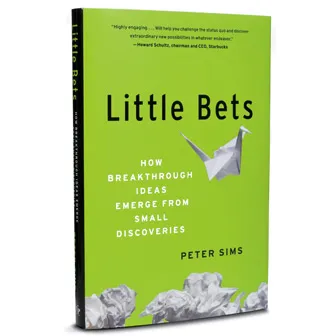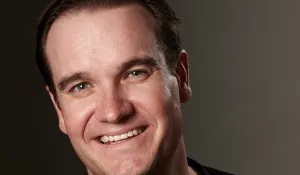[Book Review] Little Bets: How Breakthrough Ideas Emerge from Small Discoveries
by Peter Sims
2011 Random House Books (Amazon)
10 chapters, 214 pages
This book by Peters Sims joins a range of others about the importance of ‘fail quickly to learn fast’ in order to successfully innovate

and grow. What sets this book apart is the very wide range of case profiles – not just from the usual vertical categories like tech startups, but also comedians, musicians, architects, film-makers, newscasters, diplomats and even the US Army.The thinkers and doers featured include Ludwig van Beethoven, Thomas Edison, the story developers at Pixar films, Apple’s Steve Jobs, Grameen Bank’s Muhammad Yunus, comedian Chris Rock, prize-winning architect Frank Gehry, Amazon’s Jeff Bezos, President Obama’s new media campaign team, the US Army’s Chief of Strategic Plans, and companies such as Procter & Gamble, Starbucks, Google, Twitter, SAP, 3M and Hewlett Packard.
Peter Sims is an entrepreneur and author, who has collaborated with Stanford's Institute of Design (the d.school). He was previously with Summit Partners, and co-authored “True North: Discover Your Authentic Leadership.” Sims is a co-founder of Fuse Corps, a social venture that places entrepreneurial leaders on year-long grassroots projects. His articles have appeared in Harvard Business Review, Tech Crunch, The Financial Times and Fast Company.
Breakthrough results are achieved by methodically taking small, experimental steps in order to discover and develop new ideas, Sims explains. Instead of linear thinking and long-term plans, successful innovators make a series of little bets about what might be a good direction, learning from lots of little failures and from small but highly significant wins.
Sims explains how principles of adaptive design thinking and customer immersion were behind Hewlett-Packard stumbling onto the breakaway success of the first hand-held calculator; the storyboarding process at Pixar films that has driven their box office successes; the playful discovery process by which Frank Gehry arrived at his design for Disney Hall; the evolution of Google’s ad strategy and Amazon’s affiliates program; and even the US Army’s approach to counterinsurgency operations.
The key steps to Sims’ ‘little bets’ approach are:
- Experiment: learn by doing, with small prototypes
- Play: Stimulate creativity through play and humour
- Immerse: Get insights and ideas from the ground up
- Define: use insights from experimentation to define new problems
- Re-orient: Be flexible and pivot when necessary
- Iterate: Repeat, refine and test assumptions.
“A little bet is a low-risk action taken to discover, develop, and test an idea. So, for instance, Chris Rock develops new comedy routines by making little bets with small audiences, while Amazon’s CEO Jeff Bezos makes small bets to identify opportunities in new markets,” explains Sims.
Such techniques are important in times of growing uncertainty, when innovators may not even know what problems they are trying to solve. While there is certainly a place for ‘big bang’ inventions and ‘big bets,’ there is more widespread application for principles based on agile development.

According to HP co-founder Bill Hewlett, the company needed to make 100 small bets on products to identify 6 that could be breakthroughs. Little bets are for learning about problems and opportunities while big bets are for capitalising upon them, according to Sims. Challenges with big bets are higher resources invested, more time, and more emotional setbacks in case of failure.Organisations need a culture of humility to become comfortable with failures, openness to be continually challenged, and resilience to bounce back repeatedly from false starts. Small wins can help with change management in winning over pessimists and naysayers in an organisation, and builds momentum for long-term product development.
A challenge for companies is that their ‘fixed mindset’ makes them gravitate towards previous successes, but they also need a ‘growth mindset’ to expand their abilities; the key to success is to tap both these mind-sets at different stages of growth.
Failures must not be seen as setbacks but as sources of learning; one must ‘fail forward,’ or ‘achieve a failure,’ in the words of Eric Ries (see my earlier review of his book, Lean Startup). “Successful experimental innovators tend to view failure as both inevitable and instrumental in pursuing their goals,” says Sims.
A good method for failing fast and learning quickly comes from agile software development, a principle now used by Intuit, Yahoo and Salesforce.com. “Agile development is not without its limitations, such as when large teams must be coordinated,” cautions Sims.
Immersion in customer environments is also key to getting creative insights and developing new ideas. A ‘worm’s eye view’ is more important than a ‘bird’s eye view’ of customer realities, according to Grameen Bank founder Muhammad Yunus, who pioneered micro-lending in impoverished communities.
Immersion in the world of driving and underwater reefs helped Pixar develop Cars and Finding Nemo. Steve Jobs’ insatiable curiosity led him to draw insights from Xerox PARC’s graphical user interfaces. HP’s style of “management by walking around” helps get new employee insights.
“Questions are the new answers,” Sims succinctly describes, and such questioning of assumptions comes from both diving deep as well as casting wide nets. An openness to experience helps improve the luck factor in raising the right questions and answers.
Lucky people increase their odds of chance encounters through wider and more diverse interactions. Insights can be drawn not just from experts and academics but also from lay people, janitors and taxi drivers.
Sims cites the work of innovation professor Saras Sarasvathy, who has come up with concepts such as affordable losses and landmarks (identifiers of pivot points); and Nassim Taleb (author of Black Swan), who addresses inadvertent discoveries.
Other cited books include The Talent Code (Daniel Coyle), Mindset (Carol Dweck), A Whole New Mind (Daniel Pink), Group Genius (Keith Sawyer), Change by Design (Tim Brown), The Art of Innovation (Tom Kelly), Making Ideas Happen (Scott Belsky), and The Age of the Unthinkable (Joshua Ramo).
In today’s globalised economy where people make career switches often, little bets can also “become a way to see what’s around the next corner,” Sims explains.
“The most powerful and profitable ideas are produced by persistent people who mess with lots of little ideas and keep muddling forward until they get it right,” according to Robert Sutton, author of Good Boss, Bad Boss.
Ingenious ideas rarely spring into people’s minds fully developed; they emerge through a rigorous experimental discovery approach. Companies should ‘do to be able to think rather than think in order to do,’ Sims sums up. Ideas and passions must go side by side with exploration and tinkering.
The book is filled with many humorous quotes, it would be apt to end this review with some of them:
“We don’t actually finish our films, we release them.” – John Lasseter, Pixar
“Creativity is just connecting things.” – Steve Jobs
“Behind every great entrepreneur is a spouse rolling her eyes.” – Richard Tate, Cranium
Follow YourStory's research director Madanmohan Rao on Twitter


![[Book Review] Little Bets: How Breakthrough Ideas Emerge from Small Discoveries](https://images.yourstory.com/cs/wordpress/2012/12/Peter-SIms.jpg?mode=crop&crop=faces&ar=1%3A1&format=auto&w=1920&q=75)




